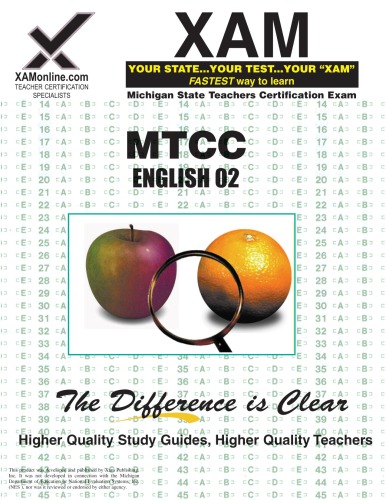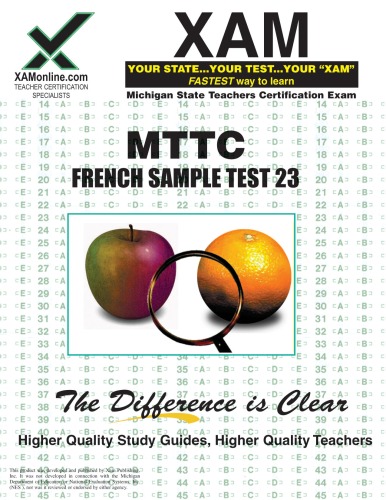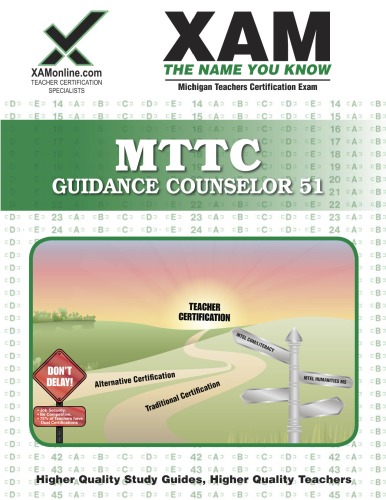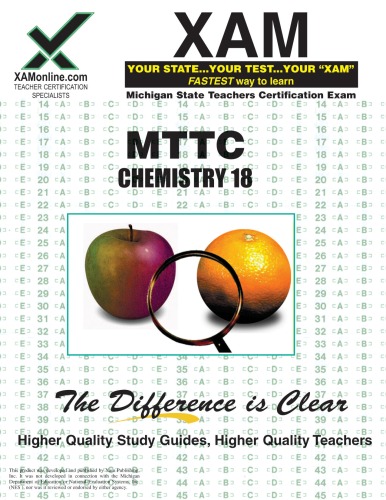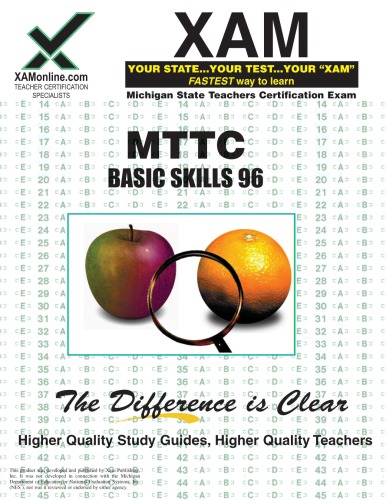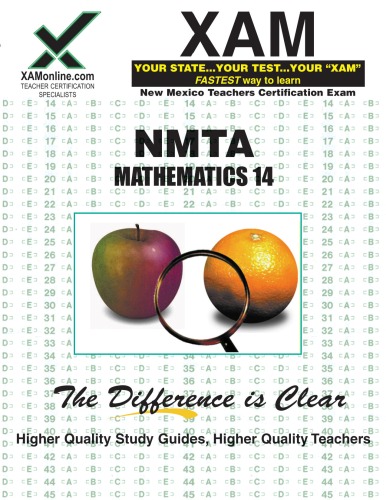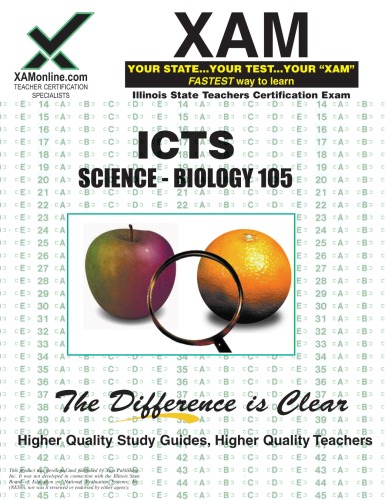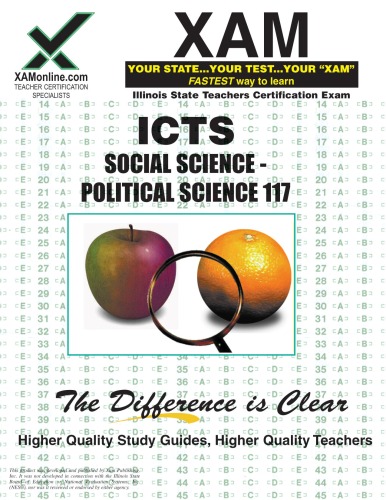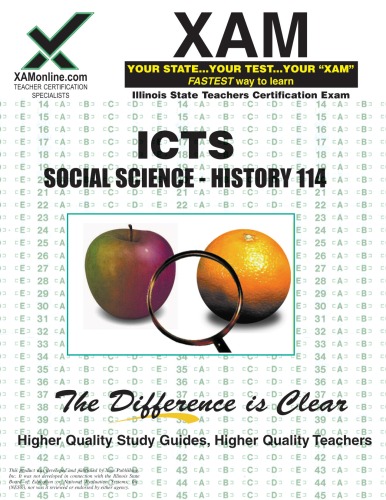(Ebook) MTTC Integrated Science Secondary 94 Teacher Certification 2nd Edition by Sharon Wynne ISBN 9781607878537 1607878534
(Ebook) MTTC Integrated Science Secondary 94 Teacher Certification 2nd Edition by Sharon Wynne - Ebook PDF Instant Download/Delivery: 9781607878537 ,1607878534
Full download (Ebook) MTTC Integrated Science Secondary 94 Teacher Certification 2nd Edition after payment
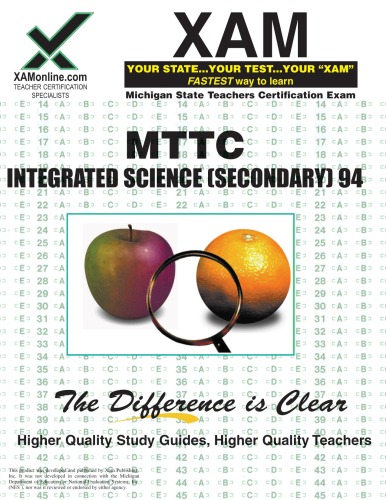
Product details:
ISBN 10: 1607878534
ISBN 13: 9781607878537
Author: Sharon Wynne
a comprehensive study guide designed to help educators prepare for the Michigan Test for Teacher Certification in Integrated Science at the secondary level. The book provides an in-depth review of key scientific concepts across biology, chemistry, physics, and earth and space science, emphasizing the integration of scientific disciplines and inquiry-based teaching methods. It includes detailed explanations, sample questions, and test-taking strategies aligned with state standards to ensure mastery of both content knowledge and pedagogical skills. This edition is particularly valuable for aspiring science teachers seeking certification, as it combines theoretical understanding with practical application to support effective science instruction in secondary classrooms.
(Ebook) MTTC Integrated Science Secondary 94 Teacher Certification 2nd Edition Table of contents:
Skill 1.1 Understand the integrated nature of listening, speaking, reading, writing, critical thinking, viewing, and visual representation
Skill 1.2 Understanding the relationships among oral, written, enacted and visual texts
Skill 1.3 Understanding the benefits of using integrated English language arts skills to foster lifelong learning
Skill 1.4 Recognizing ways in which English language arts skills can be used to explore important issues in other disciplines and communities
Skill 2.1 Analyzing the development of the English language as influenced by historical and contemporary events
Skill 2.2 Relating English derivatives, borrowings, and slang terms to their origins in other languages and dialects
Skill 2.3 Analyzing regional and social variations in language in the United States
Skill 3.1 Applying principles of language acquisition and use
Skill 3.3 Recognizing the connection between language arts and the development of competence in other subject areas
Skill 4.2 Understanding the reciprocal relationship between language and concepts related to identity, customs, and daily life in various cultures
Skill 4.3 Understanding the sociopolitical uses of language, including the issues of censorship
Skill 5.1 Analyzing the effects of environmental and circumstantial factors on a listener’s ability to understand a spoken message
Skill 5.2 Analyzing the role of critical-thinking skills in effective listening and speaking
Skill 5.3 Recognizing the role of body language, gestures, and visual aids in communicating a point of view
Skill 5.4 Recognizing the effects of voice and intonation patterns in the presentation and interpretation of oral messages
Skill 6.1 Evaluating strategies of organization, selection of details, and delivery in relation to audience and purpose
Skill 6.2 Identifying various speaking strategies and their effect on meaning
Skill 6.3 Evaluating visual materials for use in oral presentations
Skill 6.4 Identifying elements of effective communication in various contexts
Skill 6.5 Analyzing elements of effective listening and speaking in conversation
Skill 6.6 Analyzing elements of effective listening and speaking in small and large groups
Skill 7.1 Applying literary terminology
Skill 7.2 Analyzing the characteristics of fiction and the characteristics of types of fictional narratives
Skill 7.3 Analyzing the characteristics of drama and dramatic structure
Skill 7.4 Analyzing the content and formal characteristics of various forms of poetry
Skill 7.5 Analyzing the characteristics of nonfiction genres
Skill 7.6 Recognizing universal themes and substantive issues in all genres of literature
Skill 8.1 Understanding that literature can enrich the reader’s appreciation of differences and similarities in culture, race, gender, religion, ethnicity, socioeconomic status, and national heritage
Skill 8.2 Understanding that studying literature can enhance the reader’s appreciation of the experiences of others from a historical perspective
Skill 8.5 Recognizing the benefits of a lifelong enjoyment of reading
Skill 9.1 Analyzing literary works as expressions of cultural values and ideas
Skill 9.2 Understanding the characteristics and cultural significance of mythology and folk literature
Skill 9.3 Evaluating literary responses of major writers to social conditions, historical events, and religious movements
Skill 9.4 Recognizing how an author’s interests and background may influence his or her work
Skill 10.1 Analyzing the significance of writers, works, and movements to the development of North American literature
Skill 10.2 Analyzing changes in literary form and style in U.S. literature from the colonial period to the contemporary period
Skill 10.3 Analyzing the literary responses of North American writers to social conditions, patterns of inclusion and exclusion, historical events, and cultural movements
Skill 11.1 Understanding the significance of major writers, works, and movements in the development of British literature from the Anglo-Saxon period through the twentieth century and other major writings in English from regions other than Great Britain
Skill 12.1 Understanding the significance of major literary forms, works, and writers associated with various world cultures from ancient times through the twentieth century and analyzing significant themes and characteristics of major world writers and literary movements
Skill 13.1 Understanding major genres, works, and writers in children’s and adolescent literature
Skill 13.3 Analyzing the themes of works written for young people
Skill 13.4 Applying strategies to select developmentally appropriate literature for children and adolescents
Skill 14.1 Analyzing the significance of major figures and works of classical rhetoric and the theories associated with them
Skill 14.2 Recognizing the characteristics of neoclassicism and romanticism in literary theory as developed in major writing associated with each movement
Skill 14.3 Identifying concepts and individuals associated with principal movements in twentieth-century literary criticism and theory
Skill 14.4 Recognizing the interpretation of literature and other texts from given critical perspectives
Skill 16.2 Analyzing a writer’s use of ambiguity, connotation, and figurative language to convey ironic undertones, sensory impressions, or emotional effects
Skill 16.3 Interpreting the use of rhythm, rhyme, or imagery to evoke a response in the reader
Skill 16.4 Analyzing the use of language to portray character, develop plot, describe setting, or create a mood in a given passage
Skill 16.5 Recognizing universal themes
Skill 17.1 Evaluating thesis statements and supporting ideas in context
Skill 17.3 Applying knowledge of writing techniques
Skill 17.4 Evaluating the appropriateness of language and formats for various expository writing products
Skill 18.1 Understanding strategies for writing a response to a literary or media selection by referring to the text, to other works, and to personal experience
Skill 18.4 Understanding strategies for writing an analysis of an author’s use of literary elements
Skill 18.5 Identifying relevant examples from a selection to support a thesis analyzing an author’s use of literary elements
Skill 19.1 Analyzing the organization of an editorial or argumentative essay on a given topic
Skill 19.2 Distinguishing reasons, examples, or details that support a given argument or opinion
Skill 19.3 Understanding the effects of style, voice, and language choices
Skill 19.4 Recognizing the effective use of transitions to enhance the clarity of an argument
Skill 19.5 Analyzing fallacies in logic in a piece of persuasive writing
Skill 20.2 Understanding the effects of style, voice, and language choices
Skill 20.3 Demonstrating awareness of connotation and figurative meaning when selecting language for a given expressive purpose
Skill 20.4 Judging effectiveness of alternative leads and endings
Skill 20.6 Identifying passages that show rather than tell
Skill 20.7 Analyzing the effectiveness of narrative or descriptive materials and identifying appropriate revisions
Skill 20.8 Understanding uses and forms of expressive and creative writing
Skill 20.9 Applying strategies for composing personal notes and letters that entertain and interest the recipient
Skill 21.1 Applying strategies to generate ideas before writing
Skill 21.2 Evaluating the appropriateness of different writing forms for various purposes and audiences
Skill 21.5 Recognizing details that interfere with the development of a main point
Skill 21.6 Revising problems related to text organization
Skill 22.1 Understanding revision to address the writer’s purpose and audience
Skill 22.3 Recognizing resources for revision
Skill 22.4 Applying copy-editing and proofreading principles
Skill 22.5 Understanding the processes involved in preparing texts for publication in various contexts
Skill 23.2 Analyzing the contextual importance of cultural, social, economic, and historical factors to visual communication
Skill 23.4 Understanding how to use visual, auditory, and technological media to explore and create print and non-print texts
Skill 24.1 Applying knowledge of word structure and context to determine meaning
Skill 24.2 Distinguishing between general statements and specific details
Skill 24.3 From a given passage, drawing conclusions, interpreting information, and providing a summary
Skill 25.1 Analyzing the purposes and characteristics of reading techniques and strategies
Skill 25.3 Analyzing methods for enhancing reading comprehension
Skill 26.1 Identifying a writer’s intended audience and purpose for a given passage
Skill 26.3 Distinguishing between fact and opinion in a given passage
Skill 26.4 Judging the relevance, importance, and sufficiency of support in a writer’s argument
Skill 26.5 Assessing the credibility and objectivity of a source of information
Skill 26.6 Determining how the writer uses tone and style to present a particular message or point of view
Skill 26.7 Identifying and analyzing bias
Skill 26.8 Analyzing consumer information
Skill 26.9 Evaluating workplace and community documents for purpose, organization, accuracy, and relevance
Skill 27.3 Comparing multiple interpretations of a text
Skill 28.2 Understanding how writing can be used to generate authentic questions for inquiry, reflect on content and the process of learning, and explore ideas and solve problems in all content areas
Skill 29.2 Recognizing alternative ways to communicate information
Skill 29.3 Interpreting contextual information presented in charts, graphs, tables, models, and cartoons
Skill 29.4 Evaluating and selecting appropriate print and electronic visual materials for a given purpose and audience
Skill 30.3 Identifying strategies for analyzing media messages based on various factors
Skill 30.5 Analyzing the effect of visual and electronic media in shaping social attitudes
People also search for (Ebook) MTTC Integrated Science Secondary 94 Teacher Certification 2nd Edition:
mttc science
mttc integrated science test
michigan integrated science certification
mttc integrated science elementary quizlet
integrated science secondary
Tags: Sharon Wynne, Integrated Science, Teacher Certification
*Free conversion of into popular formats such as PDF, DOCX, DOC, AZW, EPUB, and MOBI after payment.


